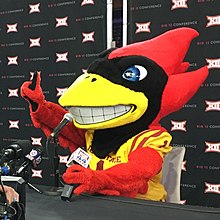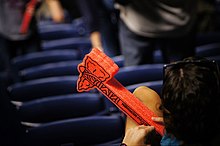Athletic nickname
This article has multiple issues. Please help improve it or discuss these issues on the talk page. (Learn how and when to remove these template messages)
|
The athletic nickname, or equivalently athletic moniker, of a
Themes
This section possibly contains original research. (April 2021) |
In the United States and Canada, multiple recurring themes have appeared over time for choosing a school's athletic nickname. In almost all cases, the institution chooses an athletic nickname with an overtly positive goal in mind, where that goal reflects the character of the institution—either a previously established characteristic or a characteristic hoped for as a goal henceforth.
Abstract concept
Often by choosing an abstract concept as its athletic moniker, the institution wants to inspire its student-athletes on and off the field to achieve success that the abstract concept represents. Examples: Cornell Big Red, Stanford Cardinal, UIC Flames, Tulane Green Wave.
Animal

Often by choosing an animal, the school wants to emphasize the instillation of fear of losing athletic competitions to the institution's teams, such as through an especially fierce or stealthy animal. When the school chooses an animal as its athletic nickname, usually in the plural or as a collective noun for a group of that animal, then typically, the school has that animal (in the singular) as its mascot,[1] either specifically named with a proper noun or generically referred to without a proper noun. Examples: Michigan Wolverines, Oregon Ducks, Princeton Tigers, Iowa Hawkeyes, California Golden Bears, Minnesota Golden Gophers, Texas Longhorns.
Collection
Often by choosing a collection that represents a summary of the institution's students or of its history. Such a collection may refer to an
Hero or archetype
A small number of schools choose an archetypical heroic person as their official athletic nickname. This person may be a graduate of the school who is viewed as embodying the school's mission or an archetypal person who is symbolic of the school's area, such as the West Virginia University Mountaineer. In religiously affiliated schools, this person may be an historical person who has received an official designation in that religion, such as a saint in the Roman Catholic or Eastern Orthodox Churches.
Native American likeness

Likenesses to
Because of protests from some Native American organizations, some schools have changed their athletic moniker and mascot and cheering practices without significant objection once the issue was raised, especially if such offense toward a group of people was viewed as incompatible with that school's stated mission or if the threat of legal action was too burdensome. Other schools or their student bodies have defended their use of Native American likenesses, especially if the institution views the use of Native American likenesses as respectful or so intimately tied with history to be inseparable from the institution, such as if the name of institution derives from the name of a tribe. Still other schools have embarked on a series of failed attempts to find a replacement.[1]
Common and uncommon names
Often, certain nicknames (animals and some abstract concepts, such as
See also
- List of college sports team nicknames
- Lists of nicknames – nickname list articles on Wikipedia
References
- ^ a b "The New York Times - Search". topics.nytimes.com.
- ^ Anderson, L. V. (2012-09-26). "Where Did the Tomahawk Chop Come From?". Slate Magazine. Retrieved 2019-10-10.
